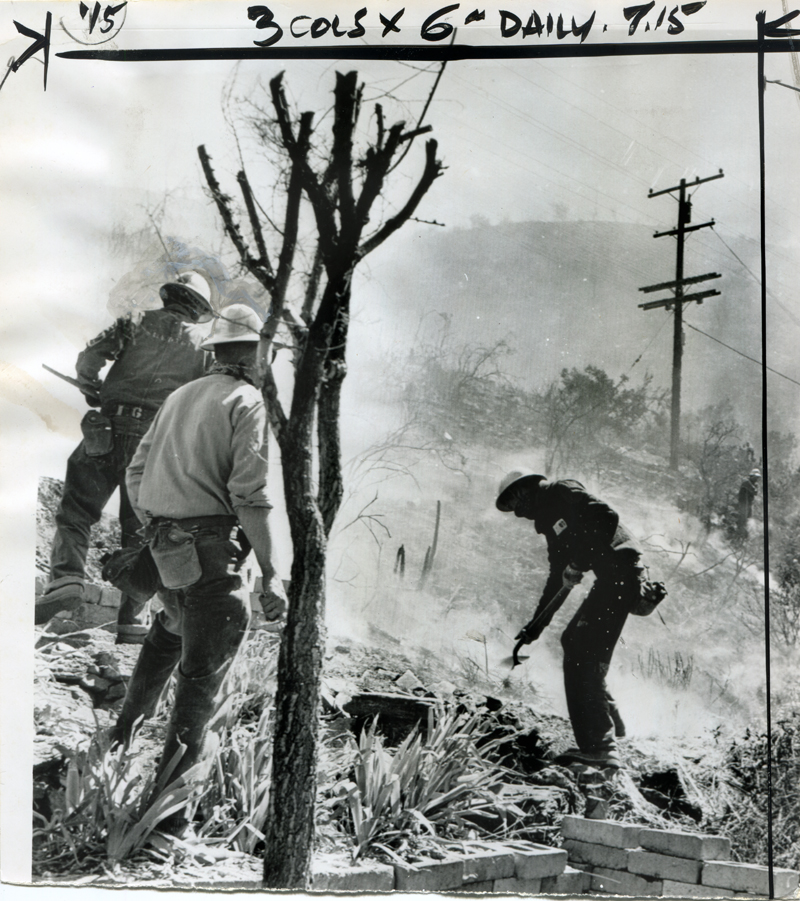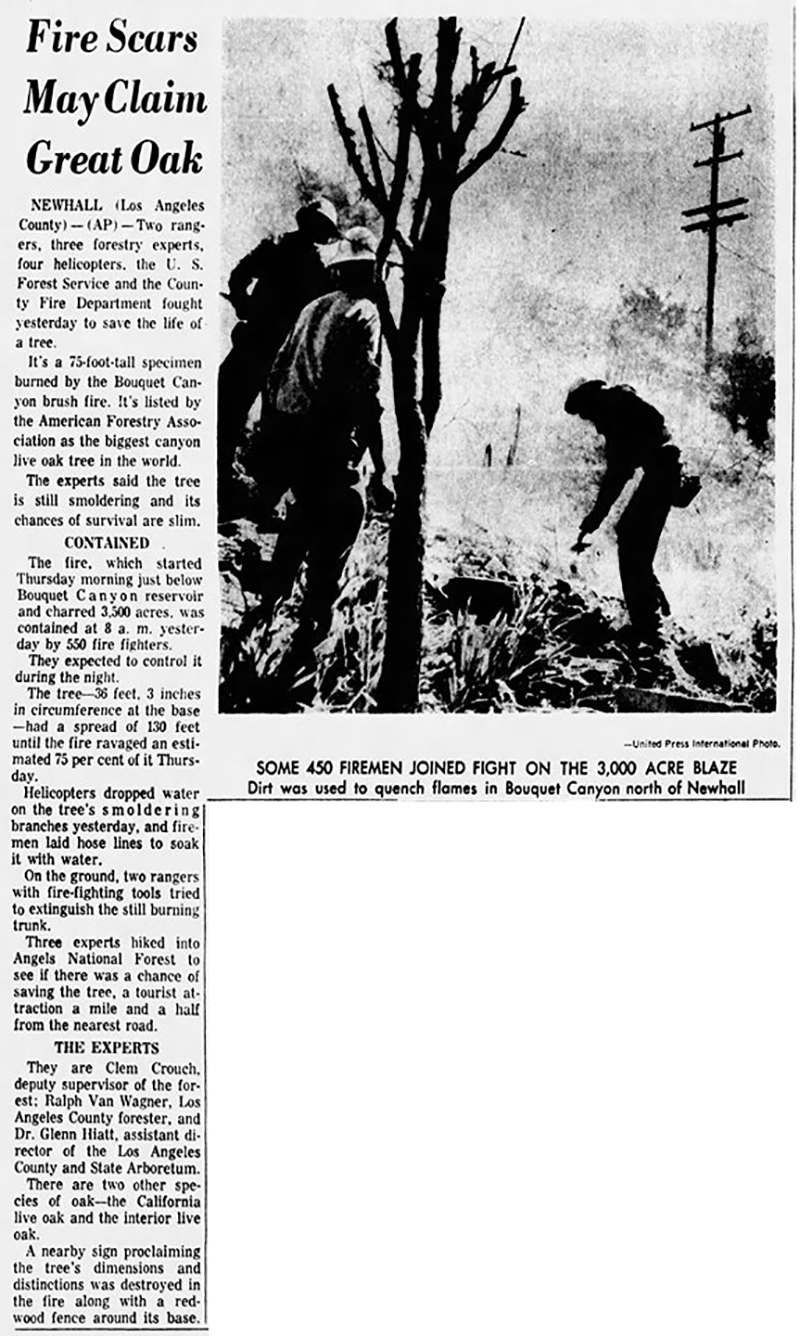|

Click to enlarge.
|
Fire Fighters Control Blaze; Start Cleanup.
Van Nuys News | Sunday, September 13, 1964.
Newhall — Cleanup operations continue today as 550 fire fighters, aided by favorable weather conditions, have controlled a huge fire which charred some 3,500 acres in the Bouquet Canyon region here, a U.S. Forest Service spokesman said.
No major damage or injuries were reported as a result of the fire which broke out Thursday at 11 a.m., 12 miles northeast of here. However, a major landmark — a giant canyon live oak tree believed to be the largest in the world — was reported nearly totally destroyed by flames.
Tour Fire Scene
In an effort to save the tall tree, one of the most popular landmarks in the Angeles National Forest, a team led by Dr. Glenn Hiatt, assistant director of the county Arboreta and Botanic Gardens in Arcadia, was sent to the scene upon request of Supervisor Warren M. Dorn on Friday afternoon.
Dr. Hiatt was accompanied by Clem Crouch, deputy forest supervisor for Angeles National Forest, and Ralph Van Wagner, chief deputy of forests for Los Angeles County after Dorn flew to the scene via helicopter shortly after noon Friday. He asked County Fire Chief Keith Klinger and County Counsel Harold W. Kennedy to draft legislation seeking stiffer penalties against arson.
Investigate Fire
Dorn said that fire fighters in the area believe that arson was the cause of the blaze. However, investigators at the scene have not listed any specific cause for the fire.
Forestry officials also pointed out that the laws involving the malicious and willful setting of such a fire are pretty stiff already.
Officials said that because the two summer cabins were destroyed, arson would be the charge if the investigation bore out that the blaze had been deliberately set.
Section 447A of the California Penal Code fixes the penalty upon conviction of arson at not less than two or more than 20 years in the state prison.
For burning the property of another, California Penal Code Section 600.5 says the punishment is a state prison term of not less than one year or more than 10 years.
Drop Water
Because the Newhall fire was on federal land, a third felony can be considered. Title 18 of the United States code says that willfully setting fire to public lands can result in a $5,000 fine, five years in prison, or both, upon conviction.
The tree, according to Don Porter, Forest Service information officer, was being doused with water from four helicopters which were ordered on the scene after the fire was declared contained at 8 a.m. Friday.
Retreat From Scene
Several fire fighters also were stationed at the base of the tree putting out hot spots in the trunk and branches of the giant live oak. Latest reports indicate that approximately 75 percent of the tree was burned.
A metal and wood Forest Service information sign located at the base of the tree, which stands 75 feet tall and has a 130-foot spread, was in twisted and charred ruins, according to reports, indicating the intense heat of the brush blaze which blackened the surrounding area.
A heroic effort was made Thursday by a crew of firemen who attempted to stand off the flames from the landmark, but were forced to retreat the scene due to flames and heat.
Release Water
The 550 fire fighters, who were brought to the fire scene soon after it was spotted Thursday morning on the east side of the canyon, were from the U.S. Forest Service, Los Angeles County and State Division of Forestry.
Thirty-five engines, eight bulldozers, at least four helicopters and five air tankers were used in fighting the blaze which was spiced by 100 degree-plus weather and low humidity.
The Los Angeles Dept. of Water & Power helped firemen by releasing water from the Bouquet Reservoir into the usually dry canyon creek, where pumps were stationed to halt the advancing flames.
Limited Damage
Heat created by the fire was intensified by chaparral, an oily ground cover dubbed by firemen "gasoline bush" because of its explosive qualities, which covered much of the area.
Although no major property damage was reported, latest reports indicate that some scattered cabins in canyons other than Bouquet Canyon also may have been damaged by the fire which had a front seven miles in length and was about one mile long [sic]. Patrols were still checking the area yesterday.
Soon after the fire was spotted, officials began an investigation to determine whether or not the fire was purposely started. Another fire was put out only minutes before, located about three miles from the starting point of the Bouquet Canyon blaze.
Control Operation
The blaze was centered in rough, but not altogether inaccessible terrain of both sides of Bouquet Canyon.
Fire fighting operations were directed by U.S. District Ranger Ben Lyons, Ranger Jack Horton and County Division Chief George Brunton at various stages of the blaze.
| 



